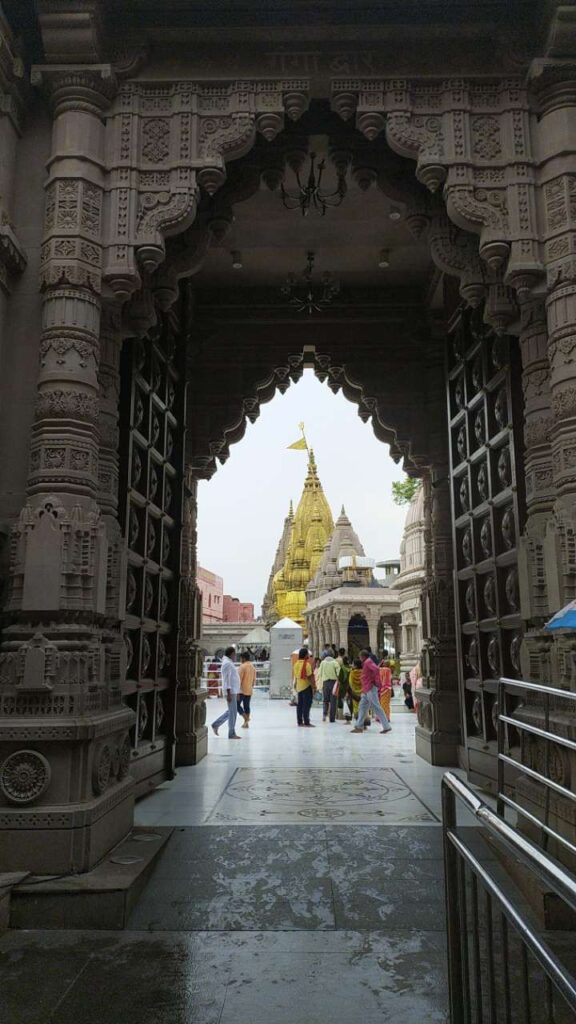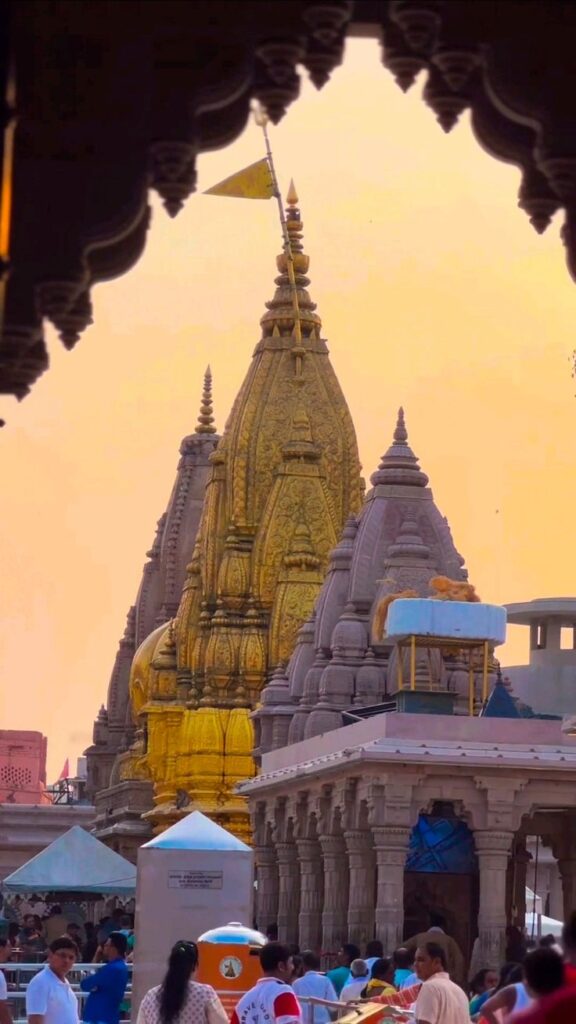One of the holiest temples in Hinduism is the Kashi Vishwanath Temple, which is situated in Varanasi, Uttar Pradesh. A popular destination for pilgrims, the temple is dedicated to Lord Shiva and is located on the western bank of the Ganges River. It is regarded as one of the Twelve Jyotirlingas.
Table of Contents


History of Kashi Vishwanath Temple
Historical Origins: According to legend, Lord Shiva himself built the temple. Shiva is credited with creating Varanasi (Kashi), one of the oldest towns in the world, according to Hindu mythology.
The importance of the temple and its relationship to moksha (freedom) are explained in the Skanda Purana, Kashi Khanda, and other ancient writings.
Early Structures: Although the initial temple’s precise antiquity is unknown, pre-Vedic references to a large Shiva temple in Kashi exist.
For thousands of years, the temple has been a vital destination for pilgrims, drawing sages, academics, and followers.
Ahilyabai Holkar reconstruction (1780): In 1780, Maharani Ahilyabai Holkar, the queen of Indore, constructed the current Kashi Vishwanath Temple.
She is recognized for having restored this famous temple as well as others around India.
Golden Dome by Maharaja Ranjit Singh (1835): The Punjabi king Maharaja Ranjit Singh gave the temple’s golden dome and spire.
For this reason, he donated about 1,000 kilograms of gold.
Development under Maratha Influence: The temple’s importance as a center of culture and religion was strengthened by the contributions of several Maratha kings to its upkeep and expansion.
Cultural religious and historical significance of Kashi
1. Spiritual Significance
- Hinduism: Kashi is one of the oldest and holiest cities in Hinduism. It is believed to be established by Lord Shiva, making it a sacred tirtha (pilgrimage site). Many Hindus aspire to visit Kashi at least once in their lifetime.
- Salvation (Moksha): It is believed that dying in Kashi or having one’s ashes immersed in the Ganges here ensures liberation from the cycle of birth and death.
- Temples: Kashi houses thousands of temples, including the famous Kashi Vishwanath Temple, dedicated to Lord Shiva.
2. Cultural and Historical Heritage
- Ancient Roots: Kashi is considered one of the world’s oldest continuously inhabited cities, with a history spanning over 3,000 years.
- Literature and Art: The city has been a center for Sanskrit learning and Indian philosophy, hosting scholars, poets, and musicians throughout history.
- Banaras Gharana: This city gave rise to the Banaras Gharana, an influential school of Indian classical music and dance.
3. Sacred Ganges River
- The River Ganga, flowing through Kashi, is worshiped as a goddess. The ghats (steps leading to the river) like Dashashwamedh Ghat and Manikarnika Ghat are sites of daily rituals, prayers, and cremations.
- The Ganga Aarti, performed every evening, is a mesmerizing spiritual experience attracting pilgrims and tourists alike.
4. Philosophical Significance
Mark Twain, the famous American author, wrote about Kashi, saying, “Benares is older than history, older than tradition, older even than legend, and looks twice as old as all of them put together.
“The city embodies the eternal flow of life, death, and spirituality, making it a timeless center of human thought and devotion.
Types of Aartis In Temple
1. Mangala Aarti (Early Morning Aarti)
Time: 3:00 to 4:00 in the morning
Significance: Conducted during the auspicious period for spiritual pursuits, Brahma Muhurta.
represents asking for the day’s blessings and waking up the deity.
need a unique ticket in order to enter.
2. Bhog Aarti (Food Offering)
11:15 a.m. to 12:20 p.m.
Significance: Committed to providing Lord Shiva with food (bhog).
After then, the devotees receive their share of the prasad.
3. Evening Aarti, or Sandhya Aarti
Time: 7 p.m. to 8 p.m.
Significance: An elaborate and colorful Aarti at sunset.
represents giving thanks to Lord Shiva for the day.
4. Decorative Aarti, or Shringar Aarti
9:00 p.m. to 10:15 p.m.
Significance: During this Aarti, the god is decked up with jewels, flowers, and other decorations.
emphasizes Lord Shiva’s majesty and beauty.
5. Night Aarti, or Shayan Aarti
Between 10:30 and 11:00 p.m.
Significance: The day’s last Aarti, offered before to the deity’s symbolic burial.
During the night, devotees look for blessings to keep them safe.
Experience the Aarti Ambiance:
The temple is incredibly spiritual, with the music of conches, bells, and chants filling the air.
In unison, devotees sing hymns while holding lights.
Rituals: Ghee or camphor lamps are used by priests.
Lord Shiva is presented with flowers, incense, and Ganges water.
Chanting: Words from the Rudram Chamakam and holy hymns like “Om Namah Shivaya” are chanted.
Engagement: Devotees can purchase special tickets to take part in the Aarti.
The administration of the temple makes sure that everything runs well for guests.
Places to Visit Near Kashi Vishwanath Temple
1. Dashashwamedh Ghat
About 400 meters separate it from the temple.
Highlights: One of Varanasi’s most noticeable and colorful ghats.
renowned for the captivating nighttime ceremony of the Ganga Aarti, which involves chanting and lighting.
a location for Ganges River boat trips.
2. Ghat Manikarnika
About 800 meters separate it from the temple.
Highlights: One of Hinduism’s most sacred cremation sites.
Reflecting the spirit of Varanasi, it is linked to the life-death cycle.
a place of worship having profound religious and historical importance.
3. Sankat Mochan Hanuman Temple
About five kilometers away from the temple.
Highlights: It is a well-known location for devotees looking for solace from problems and is devoted to Lord Hanuman.
renowned for its spiritual importance and serene atmosphere.
4.Banaras Hindu University (BHU)
The temple is around 6 kilometers away.
Highlights: An expansive campus of a prominent university.
Explore the campus’s New Vishwanath Temple, a contemporary emulation of the Kashi Vishwanath Temple.
Festivals At Kashi Vishwanath Temple
1. Mahashivaratri
When: Phalgun month, February/March
Significance: Honors Lord Shiva and Goddess Parvati’s celestial union.
regarded as the day that is most favorable for worshiping Lord Shiva.
Highlights: Throughout the day, devotees recite “Om Namah Shivaya,” maintain fasts, and perform Rudrabhishek, which involves offering water, milk, honey, and ghee to the Shiva Linga.
The shrine is exquisitely decked out with lights and flowers.
The idol of Lord Shiva is transported through Varanasi in a magnificent procession.
2. Shravan Maas
When: Shravan month, July–August
Significance: Lord Shiva is honored for the whole month of Shravan.
During this month, Mondays (Somvar) are especially revered.
Highlights: Thousands of worshippers donate water from the Ganges River to the Shiva Linga during Jalabhishek.
A large number of pilgrims visit the temple, particularly on Mondays.
3. Kartik Purnima
When: November, the month of Kartik
Significance: Honors Lord Shiva’s triumph over the demon Tripurasura.
also signifies the start of the revered Ganga Aarti custom.
Highlights: The temple has a captivating atmosphere because to the candles that illuminate it.
In order to receive blessings, devotees visit the temple and take sacred dips in the Ganges.
4. Dev Deepawali
When: Kartik Purnima, fifteen days after Diwali
Significance: It commemorates the deities’ descent to Earth and is known as the Festival of Lights of the Gods.
Highlights: Millions of diyas, or clay lamps, light up the temple and Varanasi’s ghats.
At the temple, devotees offer prayers and perform Ganga Aarti.
5. Makar Sankrati
When: January, the month of Magha
Significance: Signals the start of the harvest season and the sun’s entry into Capricorn.
Highlights: The temple hosts unique prayers and ceremonies.
Before going to the temple, devotees bathe in the Ganges for a sacred experience.
How to Reach Kashi Vishwanath Temple
1. Through the Air
Lal Bahadur Shastri International Airport (Varanasi Airport) is the closest airport.
About 25 kilometers away from the temple
Connectivity: Excellent access to important cities, including Hyderabad, Bengaluru, Delhi, Mumbai, and Kolkata.
There are also international flights from places including Bangkok, Kathmandu, and Colombo.
Transportation Options: From the airport to the temple, there are prepaid taxis, private taxis, and app-based services (like Ola and Uber).
45 to 60 minutes is the estimated journey time.
2. By Train
Varanasi Junction (Banaras Railway Station) is the closest train station.
About five kilometers away from the temple
Other Stations: Mandauadih Railway Station (about 7 km) and Kansi Railway Station (about 4 km)
Connectivity: Delhi, Mumbai, Kolkata, Chennai, and Lucknow are just a few of the main Indian cities that Varanasi is connected to by regular trains.
Options for Transportation: Outside the station, there are taxis, autorickshaws, and cycle rickshaws.
20 to 30 minutes is the estimated trip time.
3. By Road
Roads provide excellent access to Varanasi: National Highways NH 19, NH 28, and NH 31 all go through or close to Varanasi.
Private operators and the Uttar Pradesh State Road Transport Corporation (UPSRTC) provide regular bus services.
Major Cities nearby include Gokharpur (~200 km), Allahabad (Prayagraj) (~120 km), and Lucknow (~320 km).
Options for Transportation:
To get to Varanasi, you can rent buses, taxis, and private vehicles.
Advice for Travelers:
Hours of operation: 3:00 AM to 11:00 PM is when the temple is open. To prevent crowds, schedule your visit in advance.
Limitations: The temple prohibits the use of cameras, electronic devices, and leather goods.
There are safeguard storage facilities close to the shrine.
Dress Code: To honor the temple’s holiness, dress modestly and traditionally.
Peak Hours: Weekends, Aarti periods, and festivals are when you should expect the most people. For a tranquil darshan, early morning visits are best.
Weather In Varanasi(Kashi)
Read Our Other Latest Blog Jaipur journey, the essential guide to jaipur’s best 5 attractions

